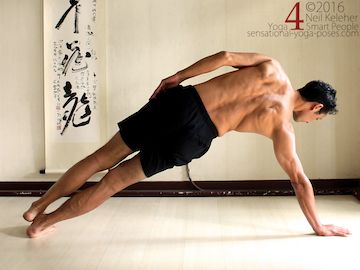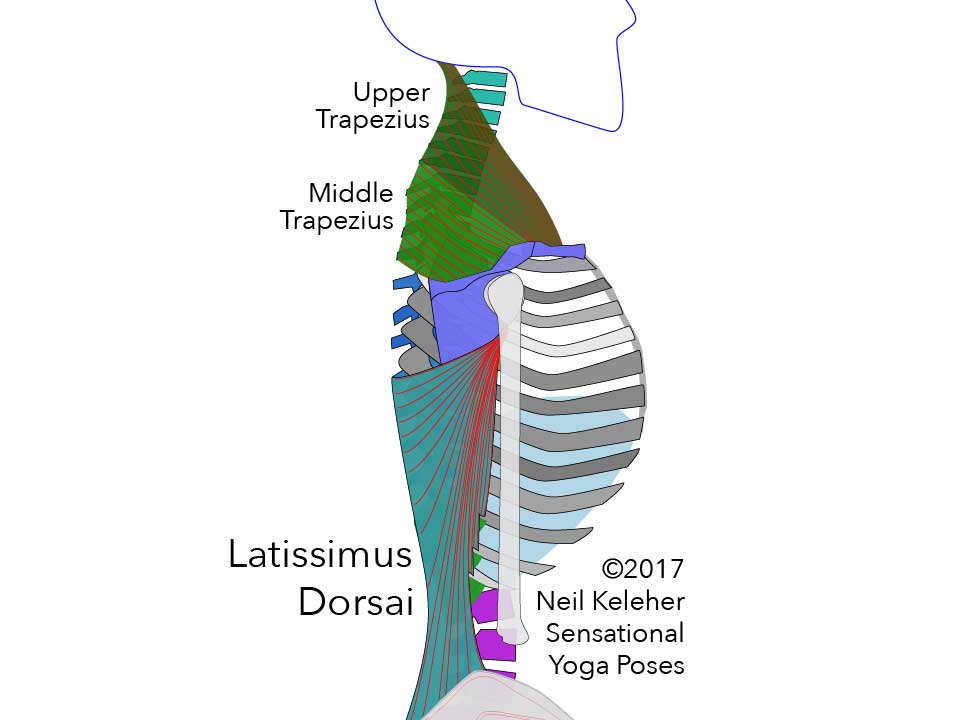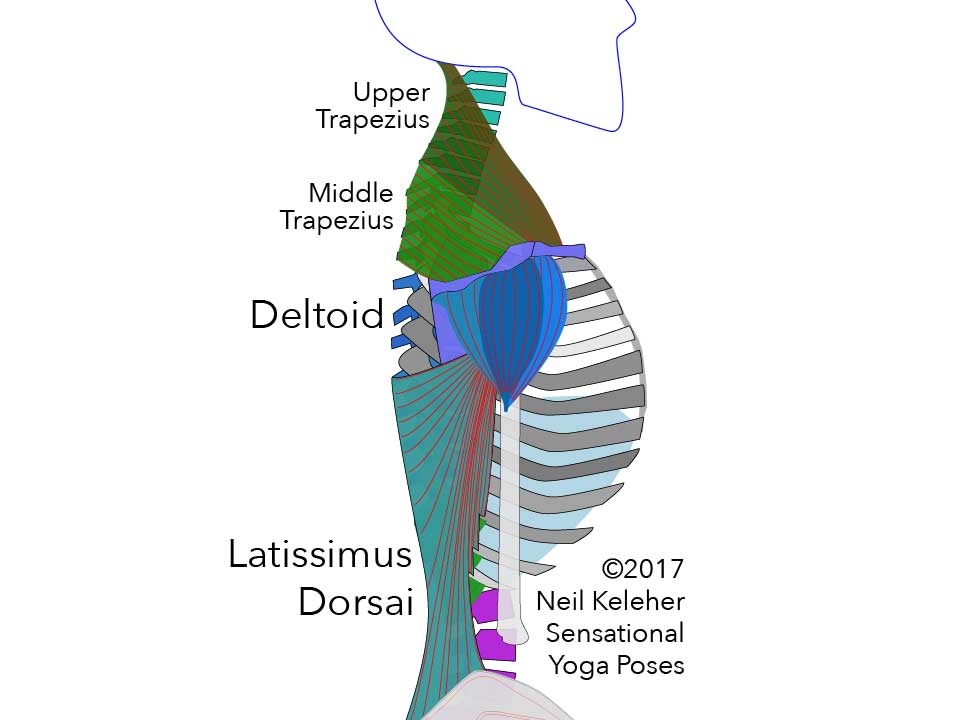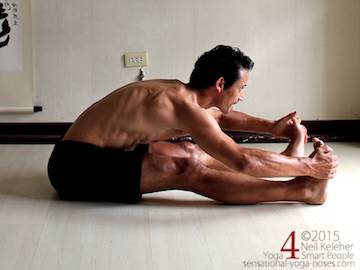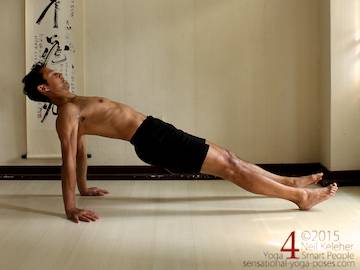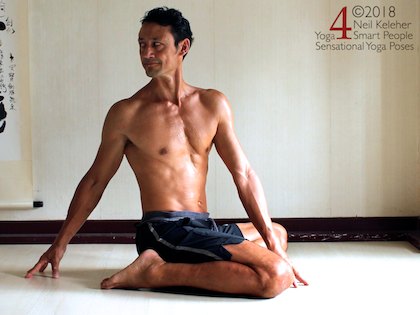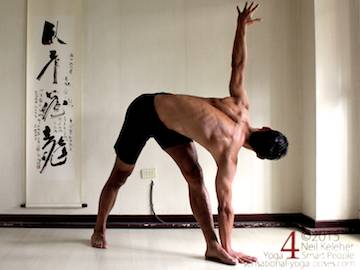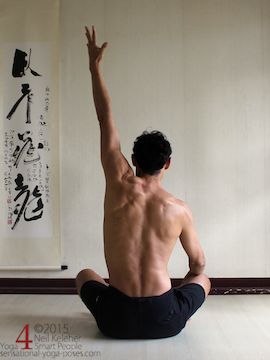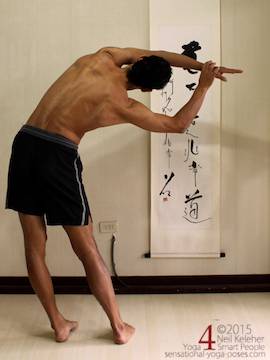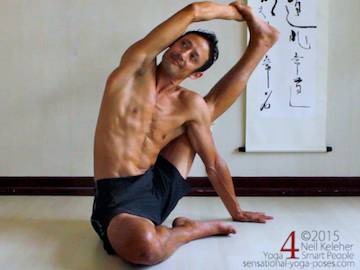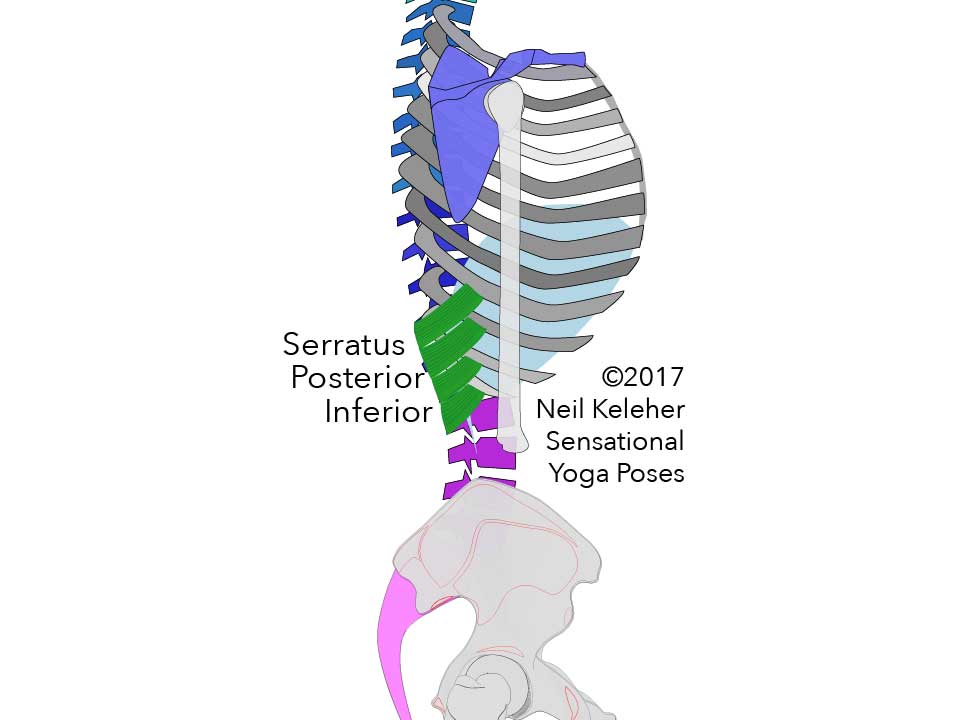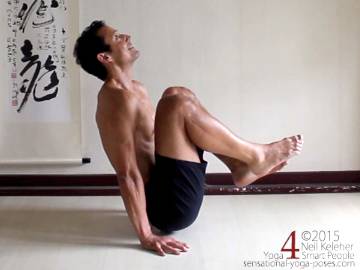Activating the Latissimus Dorsai Muscle
Anatomy for Yoga Teachers
Generally the latissimus dorsai is thought of as the muscle that we use in pull ups or chin ups. (The difference in names of these two exercises refers to the hand position. In one the palm faces forwards, in the other the palm faces back.) It can also be useful in lifting up, supporting the shoulder (as in side plank) and in twists.
Latissimus dorsai Origin and Insertion
The Muscle attaches to the lower thoracic vertebrae, lumbar vertebrae and even the sacrum as well as the back half of the iliac crests and the lower three ribs. Fibers from these points of attachment converge into a relative narrow tendon which twists before attaching the the front of the arm just below the ball of the shoulder socket.
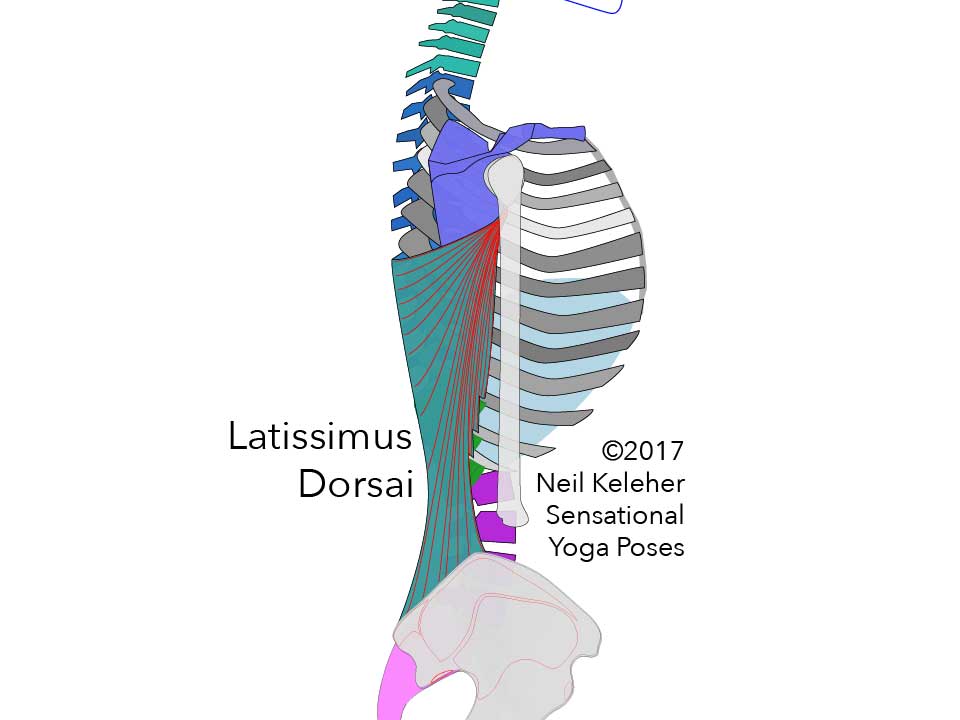
Latissimus Dorsai
Because the tendon is twisted, fibers that originate lower on the torso attach closer to the ball of the shoulder joint while those fibers that originate higher up on the back of the torso attach to the arm further from the ball of the shoulder socket.
Basic Actions of the Latissimus Dorsai
With the arms down by the sides the latissimus dorsai can be used to create a downwards pull on the upper arm bones. With the arms out to the sides the lats can be used to pull the elbows downwards and inwards.
If the arms are being pulled up then the latissimus dorsai can be used to resist the pull or slow it down.
Adding Latissimus Dorsai pre-tension via Serratus Anterior
In any action where the latissimus are being used it may help to spread the shoulder blades using the serratus anterior. Doing so ads some length to the lats, particularly the upper fibers and may make it easier to use those fibers. In addition, if the shoulder blades are kept spread it can be easier to keep the latissimus dorsai active.
The serratus anterior and latissimus dorsai then end up working against each other, at least partially, and this helps to stabilize the shoulder blade, the upper arm bone (humerus) and the shoulder joint as a result. Note that other shoulder muscles will come into play but because the shoulder blade is stabilized the muscles that attach there will have a relatively stable anchor point from which to act on the humerus.
Trapezius Versus Latissimus Dorsai
Other muscles that can work in opposition to the downward pulling action latissimus dorsai are the upper and middle fibers of the trapezius muscle.
The trapezius attaches to the base of the skull as well as to the rear of the cervical vertebrae and upper thoracic vertebrae. It's upper fibers attaches to the outer third of the collar bones, it's middle fibers to the accromion process (the bone at the top of the shoulder) and it's lower fibers all along the scapular ridge.
Note that the serratus anterior also provides opposition to the trapezius. Where the serratus anterior pulls outwards on the shoulder blades, protracting them, the trapezius pulls inwards.
When muscles oppose each other they tend to act on the same bones. In the case of trapezius versus latissimus dorsai, the former attaches to collar bone and shoulder blade while the latter attaches to the upper arm bone. As such the deltoid muscle is likely to act as an intermediary, tensing to stabilize the shoulder joint so that the lat and the middle trapezius can effectively oppose each other.
Activating the medial deltoid and supporting the weight of your head
In forward head posture, whether habitual or deliberate, the upper (and middle) trapezius are recruited to help the neck muscles support the weight of the head.
If you are an constantly in front of a computer, one option is to give the middle and upper trapezius a stable foundation from which to act. To do so, create a downwards pull on the arms via the latissimus dorsai. The arms can be in front of your body, resting on a table as if typing. Prior to trying to activate the lats, spread the shoulder blades. Then create a downwards pull on the upper arms (close to the shoulders).
You may notice that the outer portion (middle head) of the deltoids activates. This is to provide a firm connection between the two muscles. It also helps to resist the inward pull of the latissimus dorsai by creating an outward pull on the humerus.
The Latissimus Dorsai and Forward Bending Yoga Poses
It may be worth experimenting in forward bends (and in backward bends like wheel pose) with activating the latissimus dorsai for extra support of the lower back.
As an example in a seated forward bend where you are grabbing the feet, try pulling back on the feet in such a way that the lats activate. So that the lats activate imagine using your arms to pull your ribcage away from your pelvis.
Using the Latissimus Dorsai In Reverse Plank
In reverse plank, you can activate the lats by creating a forward pull on the hands. Use your hands to create a forward push on the floor (towards your feet). Prevent your feet from pulling backwards. You can try this activation prior to lifting your hips.
With torso upright, press your hands forwards against the floor (as if trying to push yourself backwards). Prevent your body moving as you do this.
You should notice sensations in your arms and torso, and even your legs that indicates that muscles have activated. Maintain these sensations as you lift your hips. Rest and repeat. You can try lifting your hips a little higher each time or every few times.
The Lats and Glutes and Twisting Poses
Some of the fibers of the latissimus dorsai that attach to the lower lumbars and/or the sacrum cross the centerline to blend with fibers of the opposite gluteus maximus. This connection forms part of what is called the Thoracolumbar complex, which in turn is part of the thoracolumbar fascia.
Because of this connection the latissimus dorsai and the opposite side glute can be used in twisting actions .
I've experimented with this in simple cross legged twists and standing poses like triangle twist and standing twist and found that using even just the glutes helped make my twists deeper, symmetrical and feel a lot more comfortable.
To get the lats active, you spread your shoulder blades while creating a simultaneous inward pull on your upper arm bones.
Reaching the Arms Upwards
With the arm(s) reaching over head all fibers of the latissimus dorsai are stretched. To increase the stretch the shoulders and the same side ribs can be lifted. In addition, because the lats attach to the front of the arm, giving the arm a slight external rotation (so that the biceps move away from the centerline and the triceps towards it) may increase the stretch of the latissimus dorsai.
Grabbing one wrist over the head and pulling it past the center line can also increase the stretch. And doing this in a standing side bend may increase the stretch even more.
Compass Pose and the Lats
In yoga poses like compass pose where the opposite hand pulls a foot behind the shoulder, the latissimus dorsai, if tight, can limit your ability to do the pose. Initially, to straighten the leg it can help to relax the arm as much as possible. However once the arm is straight the latissimus dorsai can be used to pull the arm (and the leg inwards. You may find that you can go deeper if you resist the latissimus dorsai using the hamstrings (and gluteus maximus) of the leg being stretched.
Serratus Posterior Inferior, Anchoring the Ribs for Stronger Lat Action
The lats attach in part to the bottom three ribs.
In hanging actions (chin ups or pull ups) and in yoga poses like compass pose it may help to anchor these ribs by pulling down on them prior to pulling with the lats. The muscle that pulls down on those ribs is the serratus posterior inferior which is also viewed as being a part of the thoracolumbar fascia.
The quadratus lumborum may also be useful in this regard though it only attaches to the lowermost pair of ribs (the 12th pair.)
Dangle Pose and the Lats
The latissimus dorsai can also be used in dangle pose or in the "Lift Up" phase of a seated vinyassa.
To practice activating while sitting cross legged, focus on creating a downward pull on the arms. Start by pressing the shoulders down, then work towards creating the downward pull.
To make it more likely to activate the lats try spreading your shoulder blades and keeping them spread particularly during lift off. In addition try to prevent the upper arms from rolling inwards. The arms may roll inwards anyway, but work at creating the feeling of external rotation so that your lats can work from the arms to help lift your body.
Activating Latissimus Dorsai in Side Plank
In side plank, you can activate the latissimus dorsai of the supporting arm by first pushing the palm away from you.
Keep pushing with the hand but then create an inwards pull on the upper arm to activate the lat.
Published: 2020 08 27
Updated: 2023 03 23
